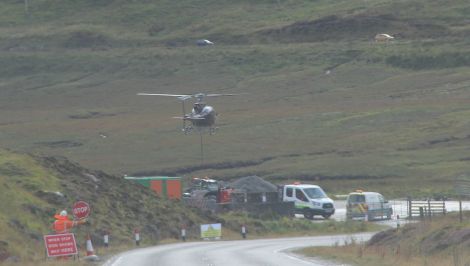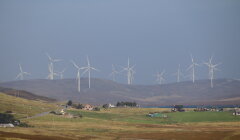Opinions / Shetland has again all eggs in one basket
The focus on building a 600Megawatt subsea cable is preventing investment in local renewable energy projects, writes James Mackenzie, the outgoing vice-chairman of Sustainable Shetland, the grassroots group that opposes the Viking Energy wind farm.
THERE have been renewed calls from politicians and developers for an interconnector cable from Shetland to the UK mainland to be provided, in spite of Viking Energy’s and Peel Energy’s unsuccessful bids in the recent Contract for Difference (CfD) auction. This is perhaps not surprising given that energy regulator Ofgem is soon to decide on the “needs case” for the interconnector.
Once again, the lack of a cable (and specifically one that will allow for large wind farms in Shetland) is being blamed for the lack of investment in renewable energy projects here.
I would argue however that it is the insistence and acceptance that the interconnector is necessary, which has stifled such investment. Just as seriously, it has actually meant that legislation is not being fulfilled as it should be.
Let me quote the Scottish Energy Strategy of 2017, and please note the opening paragraph:
“Local Energy Systems: Scotland’s Islands
“Many of Scotland’s island communities are already successfully demonstrating complex energy solutions. Their isolation from mainland energy and supply networks creates a strong incentive for innovation, helped by some of the most powerful renewable energy resources in Europe.
“Orkney, for example, is home to what was the UK’s first smart grid – connecting renewable generation to Orkney’s distribution network at a considerably lower cost than conventional network connection.
“The ‘Surf ‘n’ Turf’ project demonstrates a fully integrated energy model, with hydrogen produced using electricity from tidal and onshore wind turbines. This is stored in a fuel cell, and used to provide low carbon heat, power and transport. A European-funded project called ‘BIG HIT’ will build on the Surf ‘n’ Turf project in Orkney by producing hydrogen from renewable sources for transport and heating.
Become a member of Shetland News
“The projects will benefit the community by providing employment and training, as well as reducing harbour electricity costs and increasing revenue.
There are many other examples of innovation on Scotland’s islands and remote rural communities, supported by Local Energy Scotland.”
It is apparent, if one reads some of the documents available on the latter website, that the real barrier to investment in the present Shetland context is capacity on the local electricity distribution network, which would need upgrade and/or reinforcement to allow for local energy systems to connect to it.
The trouble is, in Shetland all the eggs have been put in one basket: large scale wind farms. It is telling that Shetland Renewable Energy Forum has been defunct, more or less since the Viking Energy wind farm was given planning permission in 2012.
The Scottish Government has recently stated: “There are, and will continue to be in future, strong cases to upgrade existing island connections to the mainland or to build new ones so that the electricity generated on the islands can help meet wider Scottish and UK demand, and to allow for profits associated with the generation thus able to connect to be reinvested appropriately on the islands.”
It will:“Continue to work closely with island partners, the network owner and all other key stakeholders to deliver existing proposals for electricity transmission links to mainland Scotland.”
These are worrying statements; coming as they do from the just published Proposed National Islands Plan (Pages 44 & 46 Strategic Objectives):
- “Wider Scottish and UK demand” implies, or at least does not question an increase in demand, when surely we should be reducing it.
- The plan, part of the Islands (Scotland) Act 2018, is supposed to be about environmental wellbeing, health and wellbeing, and empowering communities within the isles (and also reducing fuel poverty) (Page 7).
“The Act gives people more control over decisions that affect them, making it easier for local people to develop their own economies, wellbeing and environments…. In particular, when implementing the Plan, regard should be had to the Scottish Government’s Guidance on Engaging Communities in Decisions Relating to Land, which requires full and proper community engagement where significant decisions are being taken about land.” (Page 50)
I do not accept that “island partners [e.g., SIC], the network owner [SHEPD, a subsidiary of SSE] and all other key stakeholders [e.g., SSE]” fall strictly within the definition of an island community.
The people who live in the communities that would be affected by the wind farm(s) but did, and still do, object to it, have been utterly disregarded. (These incidentally include members of the crofting community who stand to gain financially from the Viking Energy wind farm, and indeed form the bedrock of Sustainable Shetland.)
It would seem to me that the whole history of Viking Energy/SSE, Peel Energy, and Energy Isles/Statkraft has shown that public authorities have acted against the Islands Act’s provisions, both at local and at national level.
This began with the forsaking of a statement made by the then SIC convenor in 2009, when presented with a petition signed by nearly 3,500 people (an unprecedented number in Shetland), that the Viking Energy wind farm would not go ahead if there was sufficient opposition.
The Shetland News of 1 July 2009 reported: “Accepting the petition outside Lerwick Town Hall, council convener Sandy Cluness, who two years ago signed the Viking Energy Partnership agreement with SSE, said he would take islanders’ concerns very seriously.
“There are large numbers of Shetlanders opposed to the size of the project and I, personally, can understand that.
“I am anxious that there should be the greatest possible debate and if the majority of Shetlanders are against it than of course we couldn’t go ahead with it.
“This is a totally representative group coming from most areas of Shetland life. As far as I can see their petition demonstrates that a fair percentage of the Shetland public are against a project of this size.”
At subsequent “consultation” meetings held by the SIC, an average of 75 per cent of those present voted against the wind farm.
As we know, however, in 2010 the SIC councillors, or nine of them out of 22 to be exact, overturned the recommendations of their planning officers who had concluded that the wind farm was contrary to the local development plan and should not be supported. Thus the automatic right to a public local inquiry (PLI) was forfeited.
Scottish ministers subsequently rebutted the advice of their own scientific adviser, Scottish Natural Heritage (SNH), ignored 2,772 individual objectors, RSPB, Shetland Amenity Trust, John Muir Trust, Shetland Bird Club, community councils, among others, all of whom had genuine concerns about the health of the environment and people, not to mention the claims of the developer about its habitat management plan and carbon savings “calculations” – which were not independently audited, as required by the government. The option of holding a PLI was dismissed, and the Viking Energy wind farm was given planning permission.
Why? Because national renewable energy targets, concerned only with electricity generation figures, and economic benefits, measured only in quantities of money, and fundamentally not in how they would address inequalities and social exclusion in the communities affected, were considered paramount.
As if this wasn’t enough, with Viking Energy’s so-called “ground investigations”, now we have a government agency (SNH) giving a green light to activity likely to impact adversely on protected bird species, against its own advice, and a planning authority unable or unwilling to take responsibility for its functions.
The Islands Plan recognizes that: “Environment is intrinsic to the economic wellbeing of island communities. Climate change and environmental context could be pivotal in transitioning the economy and creating value-added, sustainable jobs.
“The implementation of the Plan will build on, and align with, where possible, with existing green policies and strategies, such as the 2020 Challenge for Scotland’s Biodiversity, which incorporates a strategy for the conservation and enhancement of biodiversity in Scotland, Scotland’s National Peatland Plan, Scotland’s circular economy strategy and our ambitious waste and recycling targets. (Page 41)
“It is also crucial that the interdependencies between social and economic development and environmental wellbeing are realised to ensure sustainable environmental protection. A healthy environment is also essential to Scotland’s ability to respect, protect and fulfil human rights. (Page 42)
As a footnote to that, the Plan states: “In its December 2018 report, the First Minister’s Advisory Group on Human Rights Leadership explicitly recognised the importance of environmental rights, alongside civil, political, economic, social and cultural rights.Its recommendations will now be taken forward by a National Taskforce.” (Page 42)
Let me return to the Scottish Energy Strategy. One of its six priorities is: “Innovative local energy systems – we will empower our communities by supporting the development of innovative and integrated local energy systems and networks.”
It is hard to escape the conclusion therefore, that the Scottish Government’s “unstinting” commitment, as islands minister Paul Wheelhouse recently put it, to an interconnector cable which allows for industrial-scale wind farms in Shetland, is actually in contradiction to one of its energy priorities, and breaches the provisions of the Islands (Scotland) Act.
Scottish Natural Heritage and Shetland Islands Council also have duties to fulfil the Act. It is time this was recognised, and for a great mistake to be rectified.
Shetland News offered Viking Energy space in these columns to set out their thinking following the unsuccessful bid for government subsidies under the Contract for Difference (CfD) mechanism. Although they declined the offer at this time, Shetland News would welcome any contribution from Viking and/or the the other developers in the future.
Become a member of Shetland News
Shetland News is asking its many readers to consider paying for membership to get additional features and services: -
- Remove non-local ads;
- Bookmark posts to read later;
- Exclusive curated weekly newsletter;
- Hide membership messages;
- Comments open for discussion.
If you appreciate what we do and feel strongly about impartial local journalism, then please become a member of Shetland News by either making a single payment, or setting up a monthly, quarterly or yearly subscription.











































































